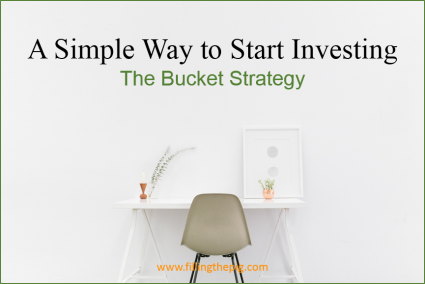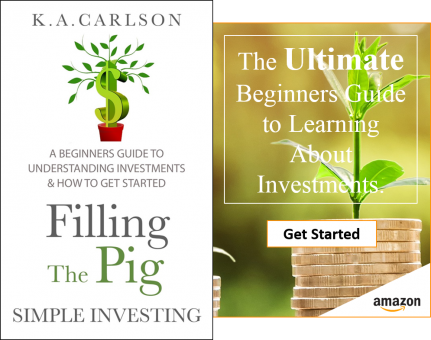Do you want to learn a simple way to start investing? Here is one perspective on how to think about investing. I call it the “Bucket Strategy”
If you’re new to investing or considering the possibility of starting, one of the most challenging aspects of the world of investing is to be able to understand the big picture.
Not from the perspective of individual stocks, bonds, mutual funds or even 401 (k)s, but rather from the perspective of how it should or could all fit together. Throw in a bunch of terms like DRIP, EPS, and Rate of Return and it’s understandable why most people won’t even attempt to start the process of learning how to invest.
However, investing and making your own investment decisions is actually pretty simple if you can approach it as a step-by-step process.
Just Like Elementary School
When you were in elementary school you learned how to spell. First, you learned the ABCs. Then you learned simple words like cat, dog, and mouse. From there you learned how to construct sentences and the different aspects of proper grammer grammar and spelling.
Investing is no different, you have to start somewhere. And there is no better place to start than to understand the big picture first before you head down the road of making decisions on individual investment types.
In the interest of keeping things simple, here is how I have typically looked at my investments from a big picture, long-term perspective.
A Simple Way to Start Investing – The Bucket Strategy
The bucket strategy is a simple way of looking at your investment landscape over the long-term – i.e. your life. It’s based on two simple concepts.
- Making more money with the money you already have will come from multiple investment opportunities, rather than just putting all your money in a single investment like a savings account, CD, stocks or bonds.
- Life is a journey and your investing requirements will change as you travel down that road. The Bucket Strategy allows you to shift your investment opportunities from one bucket to another based on your ability to tolerate risk, how much money you make, how much debt you have, or major life events like buying a home, a new car or starting a family.
But most importantly the bucket strategy is a way of looking at the investment landscape as a whole before you take that first step into individual investments.
The Bucket Strategy consists of – guess what? Three buckets. The three buckets are where you put your money to make more money.
Related Posts:
- What is a Real Estate Investment Trust (REIT)? – REIT Investing
- Creating Passive Income Through a Dividend Income Strategy
- Dollar-Cost Averaging Investment Strategy
- 3 Reasons You Should Contribute to a 401(k)
- Lower Your Taxes and Start Investing by Opening a Traditional IRA Account For Retirement
- Start Investing in Mutual Funds
- Track Stocks and Mutual Funds using Yahoo Finance (Video)
- How to Research a Stock using Yahoo Finance (Video)
- Financial Independence is About Controlling Your Own Destiny
Bucket 1
These are accounts or investments that generally have a low risk, low rate of return. However, they allow you access to your cash when you need it. This bucket consists of:
- Savings accounts
- Money Market accounts
- Certificate of Deposit – CDs
This bucket is more about having access to your cash when you need it, but still making a little extra money through the interest the accounts earn. Money for an emergency, a down payment on a house, buying a new car, that’s what this bucket is used for.
Bucket 2
These accounts should be considered long-term retirement accounts because the withdrawal of any of the funds in these accounts will result in penalties.
- Employer-sponsored retirement accounts like a 401(k)
- Self-directed accounts like a Traditional or Roth IRA
The most important aspect about these two accounts is that you can contribute to these accounts through payroll deduction or direct deposit. And in most cases, you can adjust your contribution amounts as needed depending on how much money you can, or can’t contribute.
Bucket 3
These investment vehicles are higher risk but have the benefit of a higher rate of return. These investments include:
You can contribute to these investments on a regular basis or in one-time increments based on your current income levels. And how close you are to retirement.
Now What? Start Investing
Now that you have a perspective on one way to look at the investment landscape (bucketizing) here is how you can leverage this strategy. Regardless of how much money you can save annually, here is one way based on your age to look at how you can allocate your savings into these three buckets.
You’re in your 20’s
If you have a student loan and other forms of debt you may want to allocate most of your savings to Bucket 1, so you have money for an emergency fund and don’t go further into debt. Have a new job? If you have the money to save, you could start contributing a small portion of your salary (so you can focus on paying off your debt) to Bucket 2 – your employer’s 401 (k) or an IRA account. No savings allocated to Bucket 3.
You’re in your 30s
Your income level is on the rise, and you’re considering starting a family, you could allocate 50% of your savings to Bucket 1 to prepare for the additional expenses associated with starting a family, like buying a home, raising kids. At this stage in your life, you start thinking much more long-term, maximize your contributions to Bucket 2, a 401(k) or IRA to save more for retirement.
You’re in your 40s & 50s
You have enough money in Bucket 1 to handle emergencies and you understand where your anticipated expenses will be coming from. You contribute the maximum to Bucket 2, your 401(k) or IRA. Then allocate any additional savings to stocks, bonds or mutual funds to maximize your returns before you reach retirement.
Summary
There are numerous investment strategies and of course a lot of opinions. The Bucket Strategy is one simple way to start investing. It provides a means of showing you how you can start investing based on your current debt, income and life events. A way of thinking differently about how you can shift your savings from one bucket to another. All based on what your financial goals are and where you are on life’s journey.
But most importantly, if you’re new to investing, it’s a way of thinking about how to get started.
Helpful Resources:
- 3 Steps to Start Investing Email Course
- Wealthsimple – Socially Responsible Automated Investing $0 Account Minimum
- Motley Fool – Stock Advisor
How do you “bucketize” your investments? Comment below.


